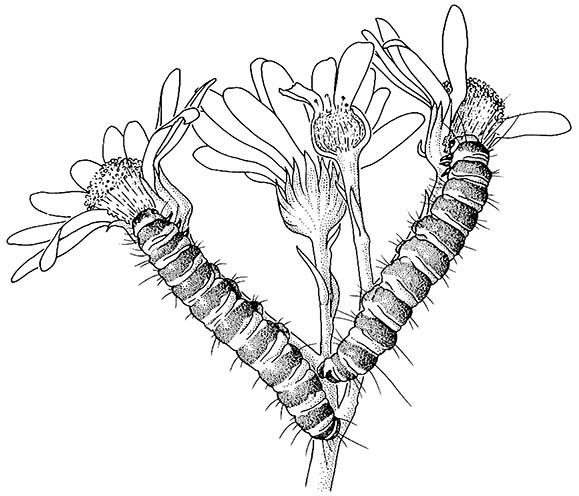14.4.3. Sources of defensive chemicals
Many defensive chemicals, notably those of phytophagous insects, are derived from the host plant upon which the larvae (Fig. 14.5; Box 14.3) and, less commonly, the adults feed. Frequently, a close association is observed between restricted host-plant use (monophagy or oligophagy) and the possession of a chemical defense. An explanation may lie in a coevolutionary “arms race” in which a plant develops toxins to deter phytophagous insects. A few phytophages overcome the defenses and thereby become specialists able to detoxify or sequester the plant toxins. These specialist herbivores can recognize their preferred host plants, develop on them, and use the plant toxins (or metabolize them to closely related compounds) for their own defense.
Although some aposematic insects are closely associated with toxic food plants, certain insects can produce their own toxins. For example, amongst the Coleoptera, blister beetles (Meloidae) synthesize cantharidin, jewel beetles (Buprestidae) make buprestin, and some leaf beetles (Chrysomelidae) can produce cardiac glycosides. The very toxic staphylinid Paederus synthesizes its own blistering agent, paederin. Many of these chemically defended beetles are aposematic (e.g. Coccinellidae, Meloidae) and will reflex-bleed their hemolymph from the femoro-tibial leg joints if handled (see Plate 6.3). Experimentally, it has been shown that certain insects that sequester cyanogenic compounds from plants can still synthesize similar compounds if transferred to toxin-free host plants. If this ability preceded the evolutionary transfer to the toxic host plant, the possession of appropriate biochemical pathways may have preadapted the insect to using them subsequently in defense.
A bizarre means of obtaining a defensive chemical is used by Photurus fireflies (Lampyridae). Many fireflies synthesize deterrent lucibufagins, but Photurus females cannot do so. Instead they mimic the flashing sexual signal of Photinus females, thus luring male Photinus fireflies, which they eat to acquire their defensive chemicals.
Defensive chemicals, either manufactured by the insect or obtained by ingestion, may be transmitted between conspecific individuals of the same or a different life stage. Eggs may be especially vulnerable to natural enemies because of their immobility and it is not surprising that some insects endow their eggs with chemical deterrents (Box 14.3). This phenomenon may be more widespread among insects than is recognized currently.

(After Blaney 1976)

